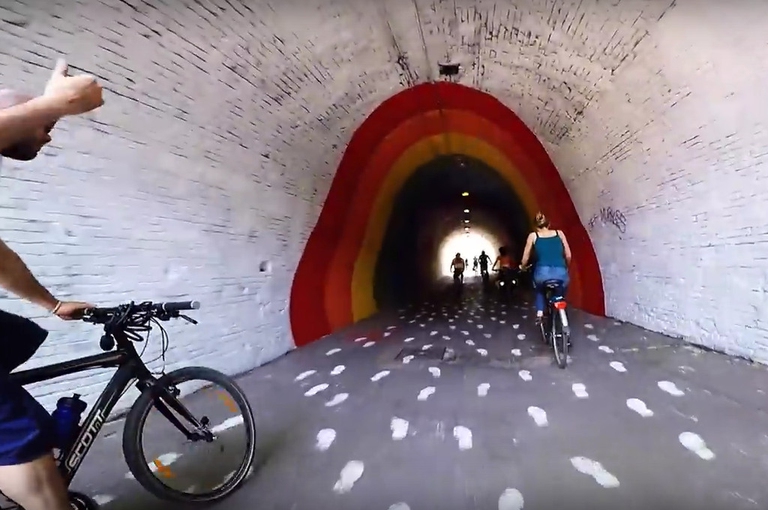
Milan has announced one of Europe’s most ambitious mobility schemes, known as Strade Aperte (open roads). Its goal is to reduce cars in phase 2 of the lockdown by increasing bike lanes and pedestrian areas.
On Saturday 10 October, Salvaiciclisti, the movement that managed to gather thousands of cyclists on 28 April 2012 crowding with bikes via dei Fori Imperiali, Rome, decided to take the big step of becoming an association, a formally and legally recognised reality that dialogue with institutions but has its voice heard to the sound of
On Saturday 10 October, Salvaiciclisti, the movement that managed to gather thousands of cyclists on 28 April 2012 crowding with bikes via dei Fori Imperiali, Rome, decided to take the big step of becoming an association, a formally and legally recognised reality that dialogue with institutions but has its voice heard to the sound of bicycle bells.
The decision was made after that the movement acknowledged that Roman institutions don’t recognise the importance of bicycles in big cities, where traffic increasingly thickens and the smog and number of accidents increase.
The straw that broke the camel’s back was Rome’s ex transport assessor’s U-turn about the construction of the GRAB and the bike lanes. Even the death of the designer of the Salvaiciclisti logo, commemorated on 10 October, pushed those who adhered to the project to take this big step, hoping that this choice will bring tangible results in the next years.
One of these results is obviously the building of the GRAB strongly supported by Rome’s Council before the clamorous about face. Equally clever was the Minister of transport’s decision to create a fund for teh realisation of cycling lanes throughout Italy, GRAB included.
In the meantime, the volunteer work done up to now resulted in the creation of GPS circuits. You can find them on the website velolove.it/grab. After downloading them you can use them in your smartphone or GPS navigator to pedal along the path in both directions. An app that guides tourists and gives them information on the sites of interest they can reach will be available soon.
Siamo anche su WhatsApp. Segui il canale ufficiale LifeGate per restare aggiornata, aggiornato sulle ultime notizie e sulle nostre attività.
![]()
Quest'opera è distribuita con Licenza Creative Commons Attribuzione - Non commerciale - Non opere derivate 4.0 Internazionale.
Milan has announced one of Europe’s most ambitious mobility schemes, known as Strade Aperte (open roads). Its goal is to reduce cars in phase 2 of the lockdown by increasing bike lanes and pedestrian areas.
Formula 1, the world’s most important auto racing championship, has decided to turn the page and aim for carbon neutrality with the support of its teams, drivers and the whole racing circus.
Toyota and LifeGate began telling the story of hybrid mobility back in 2006, now, on the road to the Tokyo 2020 Olympics, they’re still treading the path of sustainable mobility. Here are the main steps of the journey.
Germany’s first solar bicycle lane could be the prototype for the roads of the future. The photovoltaic tiles melt snow and ice, and are capable of absorbing noise.
The Vespa is back in an electric version. Production has just started and the first models can be reserved online starting from October.
The city of Utrecht, in the Netherlands, is home to a bridge for cycling and walking that stretches over roof garden of a Montessori school. This project enhances practicality and will allow families to bring children to school by bike, passing through green areas. Despite their functionality, bridges are often seen as an infrastructure that is
The Lego hair bike helmet is the latest Internet craze. For now it’s just a prototype but production on a large scale will probably start soon.
Just as fires often give way to new growth, after the Dieselgate scandal, which saw Volkswagen cheating on US emission rules, the German car manufacturer radically changed course, beginning to focus on sustainable mobility. The German car company aims to propose thirty zero-emission models and produce at least one million battery electric vehicles by 2025. An ambitious mission
Sustainable, two-wheel mobility is triumphing in Copenhagen. After years of investments, policies, and infrastructural changes, bikes now outnumber cars in the city centre. The website Copenhagenize has released data linked to the number of vehicles entering the city centre, which are monitored by the city’s administration on a daily basis. Last year, 265,700 bikes have entered








